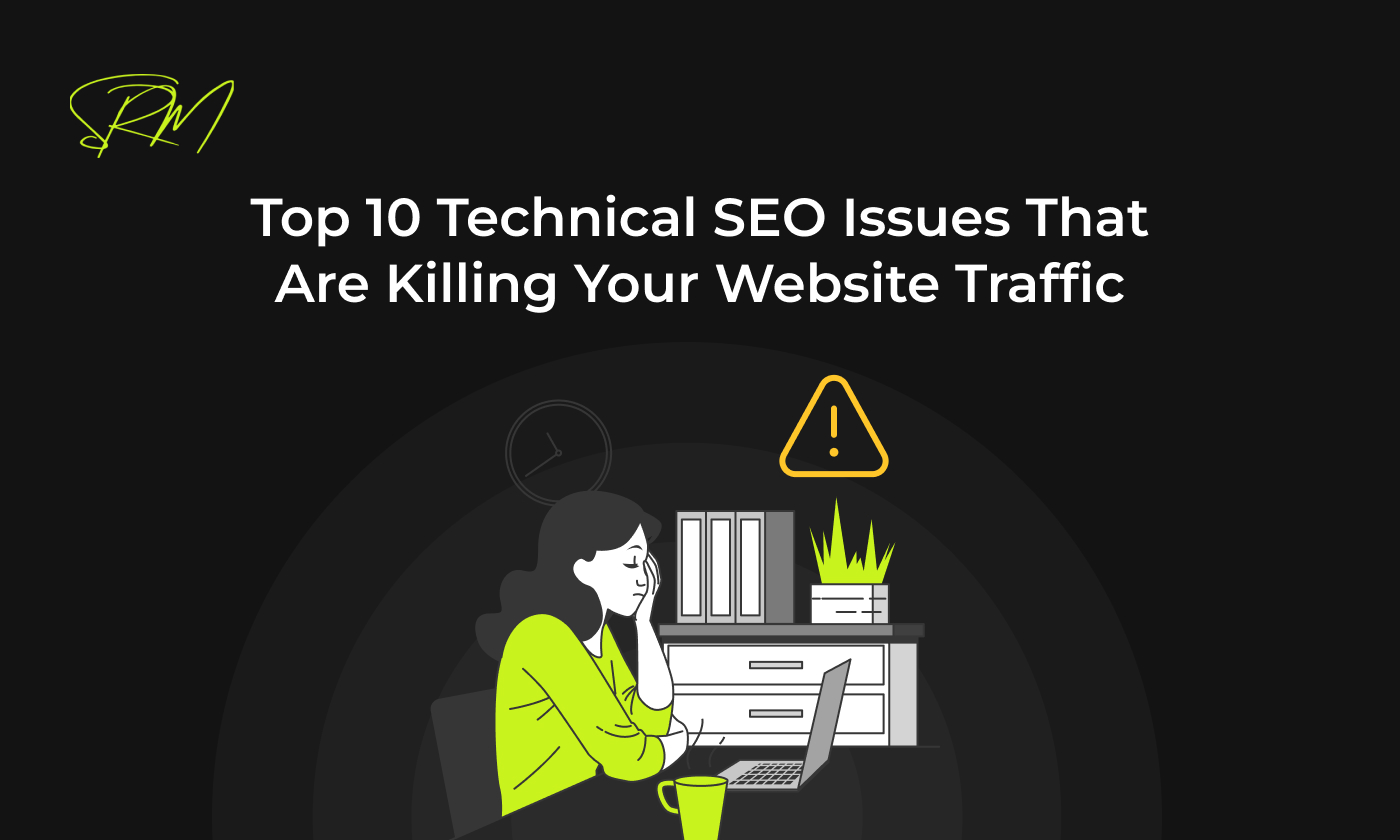
You’ve spent hours crafting valuable content, targeting the right keywords, and promoting your blog on social media. Yet, your website traffic still isn’t growing. What’s missing?
What’s missing?
The truth is, even with great content, your website won’t perform well in search engines if it has technical SEO issues. These are often hidden problems that hurt your site’s visibility and confuse search engines like Google.
Technical SEO helps search engines like Google crawl, understand, and index your website properly. If there are problems behind the scenes, it doesn’t matter how good your content is—people may never see it.
Let’s take a closer look at 10 technical SEO issues that could be quietly damaging your site’s performance—and how to fix each one.
1. Slow Website Speed
One of the biggest technical SEO issues is a slow website. If your pages take too long to load, visitors will leave before they even read your content. Search engines also notice this and push your site down in the rankings.
Why it matters:
- Users expect websites to load within 2-3 seconds.
- A slow site increases bounce rate (people leaving quickly).
- Google uses page speed as a ranking factor.
How to fix it:
- Compress images to reduce file size.
- Use browser caching.
- Minify CSS, JavaScript, and HTML files.
- Use a Content Delivery Network (CDN) if possible.
2. Broken Links (404 Errors)
One of the most common technical SEO issues is having broken links on your website. These are links that point to pages that no longer exist or return a “404 Not Found” error. Search engines and users both rely on smooth navigation—when links are broken, it disrupts the user journey and affects your site’s crawlability.
Why it matters:
- Broken links are serious technical SEO issues that prevent search engines from properly crawling and indexing your website.
- They hurt user experience, reduce trust, and can lead to higher bounce rates.
How to fix it:
- Use SEO tools like Screaming Frog, Ahrefs, or Google Search Console to scan for 404 errors.
- Replace broken internal and external links or update them to point to relevant live pages.
- Set up 301 redirects for deleted or moved content to guide both users and search engines to the correct page..
3. Duplicate Content
Duplicate content is a common but often overlooked technical SEO issue. It happens when the same or very similar text appears on multiple pages—either within your own site or across different websites. Search engines get confused about which version to index or rank, which can harm your visibility in search results.
Why it matters:
- Creates confusion for search engines, which may not know which page to prioritize.
- Can split ranking power between multiple pages with the same content.
- May lead to lower rankings or even indexing issues.
How to fix it:
- Write unique, original content for every page on your website.
- Use canonical tags to signal the preferred version of a page to search engines.
- Avoid copying content from other websites, and rewrite where needed to add value.
4. Poor Mobile Optimization
One of the most critical technical SEO issues today is poor mobile optimization. With the majority of users now accessing websites through smartphones and tablets, a website that doesn’t work well on mobile devices can lose traffic fast. Google has also shifted to mobile-first indexing, meaning it primarily looks at the mobile version of your site when ranking pages. If your mobile experience is clunky or slow, both users and search engines will lose interest.
Why it matters:
- Mobile-first indexing is now standard for search engines like Google.
- A poor mobile experience reduces user engagement and increases bounce rates.
- It directly affects your SEO rankings and overall website performance.
How to fix it:
- Use a responsive web design that automatically adjusts to different screen sizes.
- Avoid large pop-ups, overlapping text, or buttons that are hard to tap.
- Regularly test your site using Google’s Mobile-Friendly Test and fix any reported issues.
5. Missing or Incorrect Robots.txt File
A robots.txt file helps search engines understand which pages they can and can’t visit on your website. If this file is not set up properly, search engines might miss important pages or show pages that were supposed to stay private. Even small mistakes in this file can lead to serious technical SEO issues and hurt your site’s performance.
Why it matters:
- Can block important pages by mistake, preventing them from showing up in search results.
- May allow access to duplicate or private pages you don’t want indexed.
How to fix it:
- Review your robots.txt file carefully to avoid critical technical SEO issues.
- Don’t block your main pages, product pages, or essential CSS/JavaScript files.
- Use Google Search Console’s robots.txt Tester to identify and fix any crawl restrictions.
6. No HTTPS (Secure Website)
Not using HTTPS is one of the key technical SEO issues that can affect your website’s trust and rankings. HTTPS shows that your website is secure, and it protects data shared between your users and the site. Google now considers HTTPS a ranking factor, so if your site still runs on HTTP, you may be losing traffic and credibility without even realizing it.
Why it matters:
- Visitors feel safer and are more likely to stay on secure websites.
- Google gives preference to HTTPS websites in search results.
How to fix it:
- Get an SSL certificate and install it on your website.
- Set up 301 redirects to move all HTTP pages to HTTPS.
- Update internal links, your sitemap, and fix any mixed content warnings.
7. No XML Sitemap
Not having a proper XML sitemap is a common technical SEO issue. A sitemap is like a guide that helps search engines find and understand the pages on your website. Without it, Google might miss some important pages, especially if your site is big or has many links.
Why it matters:
- Helps search engines crawl and index your site more efficiently.
- Tells search engines which pages are most important for visibility.
How to fix it:
- Generate an XML sitemap using tools or plugins like Yoast SEO or Rank Math.
- Submit your sitemap to Google Search Console to improve crawlability.
- Keep the sitemap updated whenever you publish or remove content.
8. Missing Meta Tags (Title & Description)
Missing or duplicate meta tags can hurt your visibility in search results and reduce user engagement. These problems are among the most common technical SEO issues. Meta titles and descriptions help search engines understand what your page is about and play a big role in whether users choose to click your link. When not written properly or used more than once across pages, they can lead to lower traffic.
Why it matters:
- Helps search engines understand your content.
- Affects how your pages appear in search results.
How to fix it:
- Write unique meta titles and descriptions for each page on your website.
- Include your target keywords in a natural and readable way.
- Keep meta titles under 60 characters and descriptions under 160 characters to avoid getting cut off.
9. Bad Redirects and Redirect Chains
Redirect chains are a hidden cause of many technical SEO issues. They happen when a page redirects multiple times before landing on the final destination. While redirects are sometimes necessary, having too many of them can slow down your website, confuse search engines, and hurt your SEO performance. It’s important to keep your redirect paths clean and direct.
Why it matters:
- Too many redirects can slow down page loading and affect user experience.
- May cause indexing problems or lead to broken links.
How to fix it:
- Use 301 redirects correctly (permanent move).
- Avoid redirecting from page A > B > C—go straight from A > C.
- Fix loops or endless redirect cycles.
10. Crawl Errors
Crawl errors are also serious technical SEO issues that occur when search engines can’t access certain pages on your website. This can happen due to problems like DNS errors, server issues, or accidentally blocked pages. If search engines can’t reach your content, they won’t index it—meaning those pages may not show up in search results at all.
Why it matters:
- Stops search engines from indexing your content.
- May cause your pages to disappear from search results.
How to fix it:
- Use Google Search Console to identify crawl errors.
- Fix server issues or remove blocks in robots.txt.
- Make sure all important pages are linked internally.
Summary
Technical SEO issues might not be visible to your visitors, but they play a big role in your site’s success. Even if you have great content, technical problems can prevent it from being seen. The good news? Most of these issues can be fixed with the right tools and a little attention.
Tip: Perform regular SEO audits to catch problems early. Even small fixes can lead to big gains in traffic and rankings.
If you’re struggling with technical SEO issues, Shiwali Ratan Mishra, an expert in digital marketing and SEO, can guide you in optimizing your site and resolving any technical problems that could be holding your site back.





